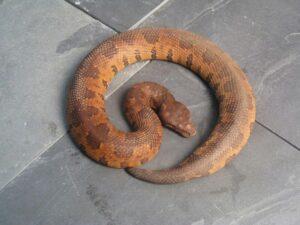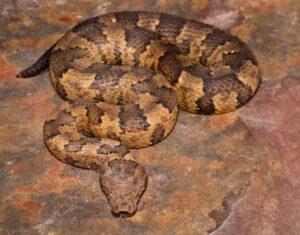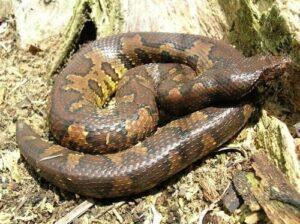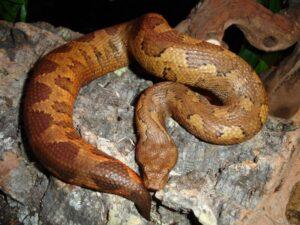Viper boa is a harmless, terrestrial, heavy-bodied snake that is also known by the names Pacific ground boa, Papuan ground viper, and New Guinea boa. They are moderately difficult to keep as pets due to their requirement for highly humid conditions. It owes its name to its triangular head and blunt nose that give it a viper-like appearance.
Scientific Classifications
- Suborder:Serpentes
- Family:Boidae
- Genus:Candoia
- Species:C. aspera
Conservation Status
Subspecies and Morphs
There are no recognized subspecies of this snake. But it has morphs of different colors that range from dark brown to orange, including black.
Description
Size
Viper boas grow to a length of 2 to 3 ft (61-91.4 cm). Their tails are just 10% of their full size.
Color and Appearance
The dark-colored boa looks like the Death Adder that is also a native of New Guinea. It is shorter than most other boas, is stocky and thick. Its head has a slight scoop that helps it to dig and burrow into the substrate. Its scales are rough and keeled. A saddle pattern runs through the entire length of its body but doesn’t extend into its belly, which is a lighter shade of yellow or tan. The body color helps it to camouflage.
The males are easily differentiable from the females as they are shorter and have long pointed spurs on both sides of their vents.
Are They Dangerous to Humans
The viper boa is more aggressive than other species of Candoia. It is uncomfortable in the company of humans and can bite if cornered.
As pets, they are even-tempered and peaceful in general. They rarely bite if socialized from a very young age and can be handled for short periods.
Viper Boas at a Glance
Distribution
They are found in New Guinea (Papua of Indonesia and Papua New Guinea). They also inhabit some surrounding islands like the Solomon Islands and Bougainville Island to the east and Manus Island to the north of New Guinea.
Habitat
Wet lowlands, swamps, and forests are their natural habitat. They prefer damp environments with lots of water as they are brilliant swimmers and enjoy soaking in water for extended periods. They also like digging.
Viper boas hunt at night. During the day, they spend most of the time burrowed in the ground or in water.
Lifespan
15-20 years.
Predators
Not known.
Diet
These carnivores eat a variety of food in the wild. It could include small mammals, reptiles, amphibians, and fish.
Reproduction
Ovoviviparous (gives birth to live young from eggs that hatch inside the body)
The snakes need to be offered a cooling period (brumation) before they start breeding at the end of January. The females are gravid for 7-9 months. The clutch size varies between 10 and 20.
Care Sheet
Temperature: The tank should include a hot spot of around 88°F. The ambient temperature should be around 80°F. At night it can drop to 75°F as long as it is brought back up in the morning.
Humidity: A high humidity level of 70-80% needs to be maintained in its enclosure. It can be achieved by including a large bowl of water, regular misting, and a damp substrate.
Substrate: The substrate should be able to hold humidity well without being soggy or saturated. It should also be loose enough for the boa to dig and burrow through. Eco Earth and Coco Fiber are excellent options for this species.
Source
i.pinimg.com, cdn.shopify.com









